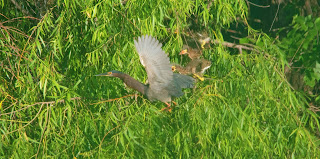Barn Swallow
Cliff Swallows
060919
0700-0730/74-75 F/mostly cloudy/NNW-4/77-79% RH/29.99-30. Hg and rising
This was a good day to observe all swallows, as many had finally fledged from their gourd-shaped mud nests along Lakeview Road Bridge. The two swallows that breed regularly in Oklahoma are Cliff, Northern Rough-winged, and Barn Swallows. Cave Swallows have been observed as far south as Manitou in 2015 and photos have been obtained for breeding birds at the Wichita Mountain NWR in 2012 with earlier breeding individuals unproven since 201l. They may have made it as far north as Lake Thunderbird in Norman in 2017. Non-breeders are also seen regularly this year along the Red River, and there could be breeding birds at Red Slough.
No doubt that within the next decade they will be breeding in Stillwater, as well, possibly at Boomer Lake. The higher likelihood could be at Lake Carl Blackwell for Payne County.
Adult Green Heron departs The Cove, as
immature Green Herons await a morsel.
Hopeful Green Herons for slurry
A Parent of Clutch 1
Young Green Herons Explore Home Base
Immature Green Herons Enticed by Other
Species in Flight
Several teen Heron Chicks
Exercise Those Wings
Getting the Right Idea By Watching Others
Rapt Attention On a Passing Great-tailed Grackle
Plenty of Stimulation For Young Minds In Area
Not Missing Anything
Young Green Heron Seeks Flight Instruction
Is Food On the Wing?
Dinner Is Served, But It Won't wait Long
Can You Hear Us Now?
Feeding Frenzy Is About to Begin
Helpers Are Here For Feeding Chores
Moving Around Faster Helps Muscles Grow
Wings and Legs Get Experience
Where's the Fish?
Helpers Make Youngsters Work
For Their Meals
Waiting Nets Nothing
Using Wings For Balance
On the Lookout
Brown Thrasher In Nest
Adults Take a Break
Waiting to Turn Fish to Slurry
061019
0719-0837/64-69 F/clear/N-11/70-64% RH/30.41-30.46 Hg and rising
It's hard work being a Green Heron, unless one is a lazy Green Heron, and like any other bird, survival means work. The young will lollygag for as long as they can, unless they are pushed by family, and sometimes they have to be pushed hard. Observing other species is important and sometimes the basis for flight is learned in that manner, but it must be done quickly in order to survive.
Birds have an accelerated growth rate. They don't live as long as humans and there's a big difference between a two-month-old human and a two month old bird, as they have to migrate during the same year. Hatching in May and heading south on the bird's own power in October is not a lot of time to grow up as a migratory species. This is part of the reason why only half the young make it to their destination for the winter (our winter), and half of those return as helpers the following year.
It is true that the adult males migrate first in many species to set up a territory. The adult female will then follow a couple of weeks later. They then build a nest and get right to business shortly after their arrival in the northern hemisphere to breed. There is no time to waste.
If they arrive when it is too cold, there may be no food in some cases. They may have to wait, and if they arrive too late, some will miss their opportunity for the season. Global warming or climate change waits for no bird.
As time progresses, the cycle may come together for many birds, but there will always be a few that continue to delay, and if that is the case, the species will not survive to prosper. However, birds have been around longer than we have, so they may realize that they must persevere through adjustments.
This will be a learning experience for them and for us. If we choose to negate the data, that is on us, but birds have very real criteria to handle, and their DNA pushes them forward.































No comments:
Post a Comment